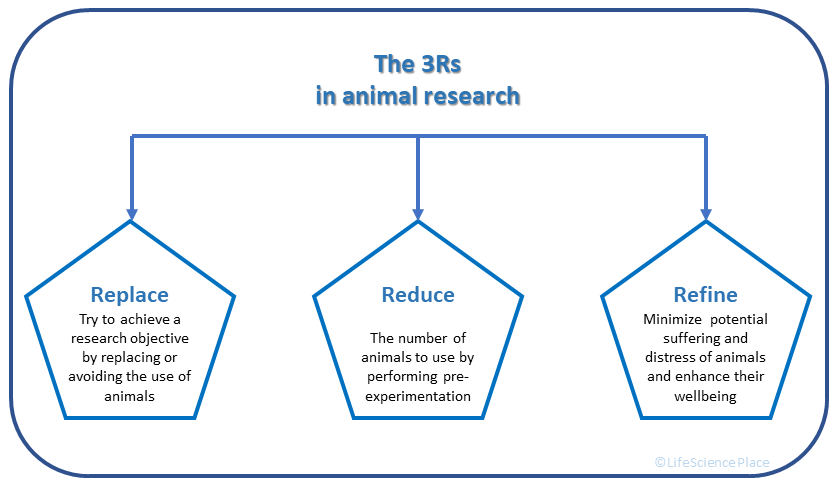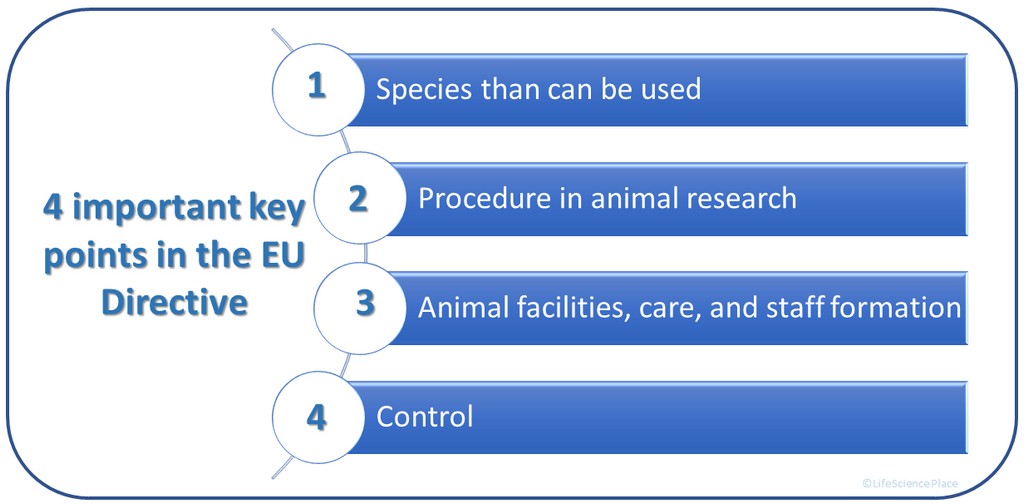
EU Regulations on Animal Research: a short review
Animal Research in the European Union (in abbreviation EU) is regulated under the main Directive published in 2010 (https://eur-lex.europa.eu/eli/dir/2010/63/oj - replace the Directive 86/609/EEC) . This directive is “related to the protection of animals used for scientific purposes” and was consolidated with another recent text published in 2019 (https://eur-lex.europa.eu/legal-content/EN/TXT/?uri=celex%3A32019R1010).
In summary, the final aims of these 2 «EU Directives» are
- to replace almost all animals used in research with non-animal methods, such as organoids, in vitro research, or even computer simulations.
- use animal facilities that can apply the EU regulation with a special staff dedicated to research that used animal models.
- animals must be used with a minimum of pain
- to perform research on animal models, the Scientist must have a convincing scientific justification and the project must be accepted by the local committee.
In the first Directive, European Union highlighted the 3Rs principles (1):
- Replacement: methods that can replace and avoid the use of animals in laboratory
- Reduction: methods (like invitro preliminary study) that can help to reduce the number of animals used in an experiment
- Refinement: methods of work that can help to reduce the pain in animals and to have a better welfare
The 3Rs are now part of the everyday practice in life sciences laboratories that use small animals for research furthermore they are included in the EU national country law and regulation.
It is important to note that EU-wide has banned animal testing for cosmetic purposes since 2013.

We can highlight in more detail the following 4 important points:
1. Species than can be used
The selection of species depends on the type, aims, and methods of the research than can be used for the relevant data, that can be obtained with a specific procedure.
What is also important is the origin of the animal to perform the research. For example, mice, rats, zebrafish, frogs, rabbits, cats, dogs, and non-human primates need to be specifically bred for research purposes. No wild animal can be used.
2. Procedure in animal research
A procedure is the utilization of an animal in research (invasive or non-invasive). The use of animals can only be done in an authorized establishment and be part of an authorized research project authorized by a legal authority.
A procedure is divided into 4 different levels of pain:
‘non-recovery’, ‘mild’, ‘moderate’, or ‘severe’.
Suffering should always be minimized, for example, by using local or general anesthesia.
The end of the procedure is when the animal is no longer studied.
Killing an animal must be done, without pain, by a qualified person using a humane procedure appropriate for the species.
3. Animal facilities, care, and staff formation
Animals used in the research procedures are kept in purpose-built-in animal-facilities houses.
They must have enough space, food, water, and even enrichment. The conditions of life including temperature and humidity must be checked daily, and furthermore, any restrictions to animals’ needs must be kept to a minimum.
The staff must be adequately trained and have enough knowledge before they are allowed to take care of the animals, carry out or design procedures, or even kill animals with an adequate procedure.
4. Control
Animal facilities must be inspected regularly by a “competent authority” and data must be recorded.
Traceability of what happens to animal use in research must be recorded.
At the end of the project, a report must be submitted to the legal committee to ensure that all animals were used for the project and with the exact amount requested.

-
What is the aim of animals being used in research?
Animals are used in scientific research to help us understand our own bodies and how they work.
This is necessary to develop new medicines and save humans life.
Animals are also used to safely test potential medicines before they are tested in people.
This is also a benefit for animal life and veterinary medicine. -
How does animal use in research benefit humans?
Testing on animals has saved and improved millions of lives in the world and particularly children.
Animal testing has benefited researchers in understanding how to treat and prevent various conditions such as high blood pressure, diabetes, tuberculosis, poliomyelitis, muscular dystrophy, and Parkinson's disease.
A lot of progress has been made in Oncology like breast cancer and leukemia. -
What is the main advantage of animal testing?
The main advantage of animal research is that it puts no human lives at risk. Experiments can take place to determine if a product or idea will work as intended. If it does, then it can be tested on humans with a lower risk of a negative outcome.
- Hits: 987